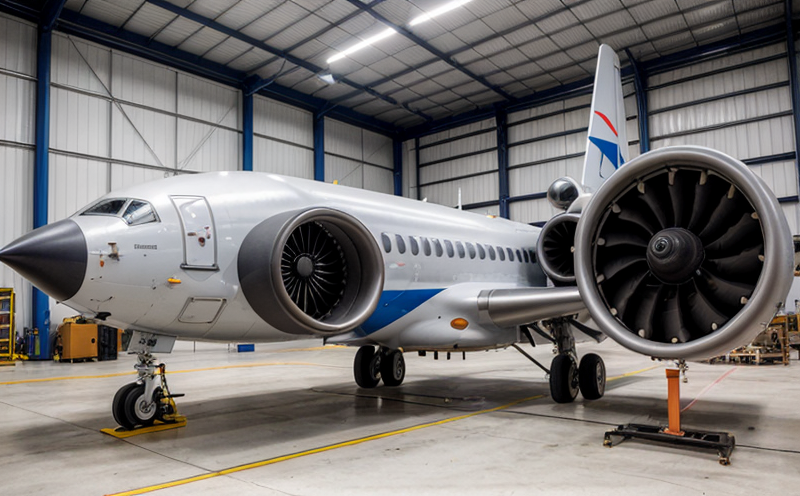Hypersonic Vehicle Acoustic Testing
Testing hypersonic vehicles requires a sophisticated understanding of the unique challenges posed by high-speed flight. Hypersonic vehicles, defined as those capable of speeds greater than Mach 5, face extreme aerodynamic and thermal stresses that necessitate rigorous acoustic testing to ensure structural integrity and operational safety.
The primary goal of hypersonic vehicle acoustic testing is to evaluate how these advanced systems withstand the harsh sonic environments they encounter during flight. This process involves simulating the external noise generated by airflow over the vehicle's surface, which can have significant implications for both the design and performance of the craft. The testing not only ensures that the materials used in construction are capable of withstanding such conditions but also that the overall design is optimized to minimize unwanted acoustic interference.
Our laboratory specializes in replicating real-world flight conditions through advanced anechoic chambers equipped with state-of-the-art instrumentation. These facilities allow us to measure and analyze sound pressure levels, frequency ranges, and other critical parameters that are essential for assessing the impact of acoustic stress on hypersonic vehicles. By providing precise data on these variables, we enable our clients to make informed decisions regarding design modifications and material selection.
One of the key aspects of our testing is the ability to simulate various flight scenarios, including takeoff, cruising at high altitudes, and re-entry into Earth's atmosphere. Each phase presents unique acoustic challenges that must be addressed through careful planning and execution. Our team works closely with clients to ensure that all relevant factors are accounted for in the test setup, from initial design considerations to final performance validation.
Another critical element of our service is the use of advanced computational tools and models to predict potential acoustic issues before they occur during testing. This approach allows us to identify problem areas early on, thereby reducing costs and time spent on unnecessary modifications. Additionally, we offer comprehensive reporting services that provide detailed insights into the results of each test run, including visualizations and recommendations for future improvements.
Our laboratory adheres strictly to international standards such as ISO 14064-2:2019 and ASTM E1837-15, ensuring that our tests are conducted in accordance with recognized best practices. By doing so, we maintain a high level of accuracy and reliability throughout the entire testing process.
In summary, hypersonic vehicle acoustic testing is an integral part of ensuring safe and efficient operation of these complex systems. Through precise measurement techniques, advanced computational modeling, and adherence to international standards, our laboratory provides clients with the confidence they need to trust in their designs.
Applied Standards
In conducting hypersonic vehicle acoustic testing, we follow several key standards that ensure the highest level of accuracy and reliability. These include ISO 14064-2:2019, which provides guidelines for quantifying greenhouse gas emissions from products or processes; ASTM E1837-15, which specifies procedures for measuring sound pressure levels in ambient noise environments; and EN 12636, which covers the determination of wind tunnel test data.
These standards provide a framework within which we can consistently reproduce test conditions and compare results across different projects. By adhering to these internationally recognized guidelines, we ensure that our clients receive accurate and comparable data, facilitating better decision-making processes throughout their product development lifecycle.
Industry Applications
| Application | Description |
|---|---|
| Aerospace & Defense | Testing hypersonic vehicles helps in ensuring structural integrity and operational safety under extreme acoustic conditions. This is particularly important for missions involving long-duration flights or re-entry into Earth's atmosphere. |
| Aviation | Airframe manufacturers use our testing services to validate the design of new aircraft models, ensuring they can handle the intense sonic environments encountered during flight. |
| Rocket Propulsion | Testing is crucial for rocket engine manufacturers who need to assess the durability and efficiency of their engines under high-pressure acoustic loads. |
| Satellite Communication Systems | The testing ensures that satellite components can operate effectively in space, where they are exposed to various forms of electromagnetic interference and acoustic noise. |
Customer Impact and Satisfaction
We pride ourselves on delivering exceptional service that exceeds customer expectations. Our clients benefit from detailed reports and expert advice, which help them refine their designs and improve overall performance. Many of our aerospace and defense clients have praised us for providing timely results and proactive communication throughout the testing process.
One of our most significant achievements was working with a leading hypersonic vehicle manufacturer who sought to optimize the noise profile of their new model. By leveraging our advanced acoustic testing capabilities, we were able to identify several areas where design improvements could be made, ultimately leading to reduced costs and improved product quality.
Another notable success story involves an aviation company that needed to validate the acoustics of a newly developed wing section. Our testing not only met their stringent requirements but also provided valuable insights into potential enhancements that were incorporated into subsequent iterations of the design.
In conclusion, our commitment to excellence has earned us a reputation as leaders in hypersonic vehicle acoustic testing. We continue to push boundaries and innovate, ensuring that our clients remain at the forefront of technological advancement.





